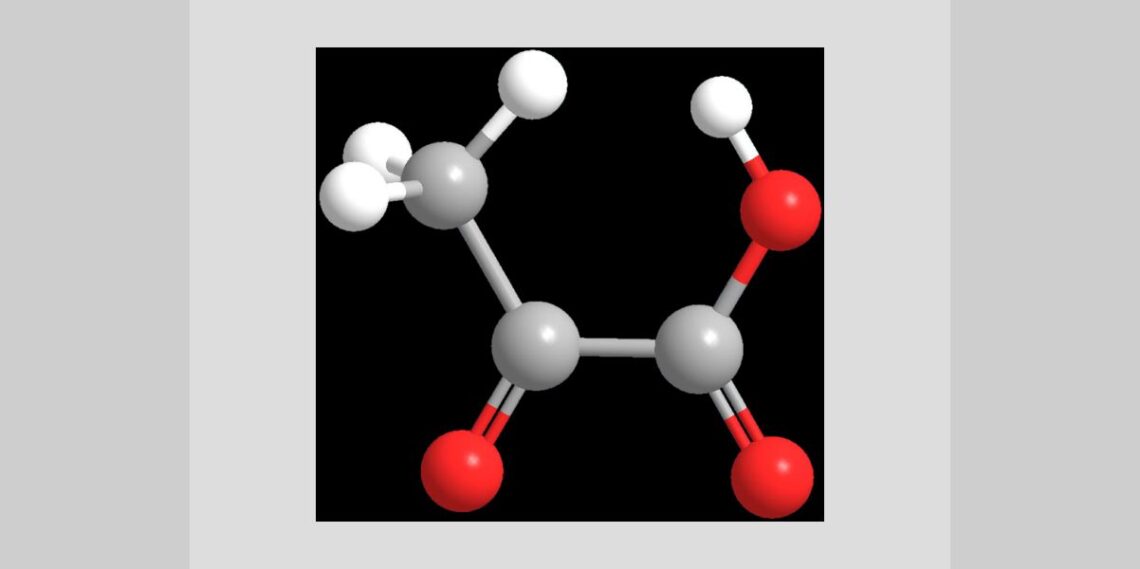Pyruvic acid is another acid involved in the Krebs cycle, hence its inclusion in the weed section as it is equally useful in the control of weeds. Of course it is also very efficacious in chlorosis of all kinds. Once the Krebs cycle is disturbed, it sets up a chain-reaction throughout all plant-processes. In this reaction, Pyruvic acid is the one produced closest to Citric acid, the initiator of the breathing process.
Chlorosis in plants follows similar patterns as tuberculosis in humans – progressive failure of the respiratory function through destruction of the tissues. Lungs are very similar to leaves and perform identical functions, hence the analogy is not far-fetched. Tubercular patients are also very pale – porcelain skin is a prominent feature of both Phosphorus and Tuberculinum. That same pallor is seen in chlorotic plants. Evidently the chlorosis in plants is very different from that in humans in appearance and requires different remedies, but the principle behind it – failure of respiratory function accompanied by tissue changes – remains the very same.
Where Citric acid acts better in the morning – not in weed control but in treatment of disease – Pyruvic acid acts better around the middle of the day, when the sun occupies the 20 degrees covering either side of Midheaven.
Oxalic and Acetic acid act better in the later hours, when the sun is in the last quarter of the sky before sundown.
The latter two and Citric acid have a different relationship to eradication of weeds. There, it is better to give Citric acid in the evening and Oxalic or Acetic acid in the morning, the opposite times of their normal activity. Pyruvic acid can be given morn-ing or evening – also outside its normal active time.
Chamomilla
Antidotal and other Relationships.
As Chamomilla is the antidote to many remedies in human application, it is self-evident that these relations extend to its use in plants. No evidence so far has pointed to the need to adjust this notion. This suggests that some remedies from the Vegetable Kingdom retain their classically known relations to other remedies.
Steiner’s preparation is equally antidotal to the same set of remedies. Such preparations must not be applied after the use of a remedy with which it has an antidotal relation. Any of the soil preparations developed by the bio-dynamic people containing Chamomilla is subject to the same restrictions.
As will be explained under the subsequent headings, elemental substances and compounds have often different relations to their commonly known ones, adapted to the circumstances under which they act in plant life.
Allelopathic* relations and Antidotes.
Allelopathic relations are either exclusively inhibitory or have a dual action. The extra effects are beneficial and stimulating and often involve plants from the same Family or Natural Order, which is different from the other effects. Hence inhibitory function may extend over the Graminae, but the beneficial may favour the Legumino-sae.
Many herbs and trees possess both properties and either cannot be grown together or are each other’s companion plant. They also display these properties in the kitchen and in the relations between remedies of the Materia Medica. Antidotal and inimical relations thus can be traced back to the circumstances in nature. Hence by studying the relationships between remedies, we can infer relations in nature and will discover the same in the kitchen. Thus we can discover which plants are beneficial to each other. Antidotes are either inimical in taste to each other or are each other’s companion in the kitchen and the garden. This is because antidotes are most often similars to and analogues of each other. At other times, they are each other’s inimicals too, besides being in antidotal relation, depending on which was given previously. The opposites therefore have allelopathic relations, while the similars belong together as companion plants.
Here we see also the Law of Similars being in all these considerations the over-ruling principle. It clarifies many relations not otherwise explicable and often puzzling to our investigations. Hence it provides a greater insight into our materia medica and makes it possible to see disease patterns and varieties and remedy-pictures in their ultimate relationships.
What is related seeks each other, begets each other, cures each other, antidotes each other as well as imitates each other and hence in the plant world grows well and close together.
Allelopathic relations are thought to work through pheromones and exudations, as well as residues of properties, often connected with alkaloids or acids. It is safer to see these relations in terms of wider parameters. While such measurable substances may play a role, it is perilous to assign causal power to results, since cause and result are always different from each other. These substances are the expressions of these relationships, rather than their direct causes.
Relationships inherently are dynamic and the dynamics of relations between plants are little if at all understood. They are studied in a merely one-sided manner and thus cannot provide more than some fragmented understanding, if any at all.
Scientific work consists mainly of making sure that all parameters have been in-cluded, lest the study is invalid. Therefore the dynamics of the relation cannot be understood, unless the conscious content is also included. Each plant has a mentality and emotional state, which is revealed through its attenuation by trituration, division and succussion. Hence the true dynamics of relationships between them cannot be obtained otherwise. There is no way in which a plant can provide us with a running account of its feelings and thoughts. In order to reveal this, the plant has to be prepared and processed in the manner described in the Organon of Rational Medicine. Only thus can the dynamic relations be revealed.
Let us now look at the different mechanical processes involved in the relations between plants.
Pheromones
Pheromones are behaviour or development mediating semi-chemicals which organisms use to transmit information between individuals of the same species. They include sex attractants, aggregation and alarm signals, trail or territory markers, ovi-position deterrents or compounds, which induce gamete release or control more complex social behaviour and govern many other activities. Most of these species-specific messages are coded in complex multi-component mixtures released in extremely small amounts.
From this fact we can understand that homoeopathic remedies, which also work in extremely small amounts are eminently fit for their purpose and role in plant life. We must not be lured into believing that a single aspect has such an impact, but understand that the complexity of the remedy is in itself guarantor that all aspects of the plants’ life are affected. Since the messages are often species specific, we can derive great benefit from their study and employment. Pheromones are in human treatment restricted to what is termed aromatherapy, but remedies made from these aromas can have a powerful effect on all living entities, provided the dose is sufficient to elicit a reaction. On plants these reactions need the smallest amount possible, following the Law of Minimus Maxima, which occupies an equally important place as the Law of Similars.
Chemical Communication
Chemical communication among insects is often elaborate and multifaced. Knowledge of the function of these systems and of the molecular structures of the chemicals involved provides the basis of highly selective techniques of pest control. Modern methods in integrated plant protection and forest pest management employ synthetic insect semiochemicals in various ways.
While these are often effective in the early period of their employment, the concept of minimum dose is not followed, leading to rapid development of resistance, since it is not dependent on the chemicals, but on the totality of the source of them, coupled to the minimum dose. As is known from Bacillus thuringiensis, resistance is a fact and the substance has become almost obsolete as a result.
Monitoring
Traps baited with synthetic pheromones are used to monitor the build-up of infestations, to optimize the timing of other operations in pest control, and to check the efficiency of these control methods. While these fulfill a necessary and useful function, we must keep in mind that they may attract more pests, because of their function as a lure.
Mass trapping
Population densities may be kept below the economic damage threshold by mass trapping with attractive baits. This is another form of killing off insects unnecessarily and is as a control measure inadequate.
Disruption
Mate-finding may be disrupted by deploying overdoses of female sex pheromones to cause disorientation of the males. This is of course an option, but it re-quires knowledge of the optimum circumstances surrounding mating and careful timing to coincide with it. Moreover, both mass trapping and disruption miss the entire essence of control – they forget the plant.
Repulsion
Deterrents which signal “keep away” may be used to repel insect pests. These are again aimed at the pest and forget entirely that it is the plant which suffers and therefore needs treatment.
Allelochemicals
Allelochemicals play important roles in interspecies communication. They constitute signals in predator-prey relations, host-parasite and herbivore-plant interactions, and may be responsible for attraction as well as chemical defense. Recognition, location and selection of prey. hosts or habitats as well as pollination behavior are strongly influenced by both volatile and nonvolatile compounds.
Herbivores may derive benefits not only from the energy content of their food but also by exploitation of secondary metabolites which the plant contains. Direct responses of plants to attack by herbivores or to infection by microorganisms include biochemical reactions, such as the production of defensive “phytoalexins”, and changes in the production of other secondary plant constituents. Under insect attack, plants may produce signals which attract insect predators providing a mutual benefit at two different levels. Volatile compounds have been identified which are released by damaged plants and which induce defense mechanisms in other nearby individuals.
Allelopathy
Allelopathy involves chemical interactions at all levels of complexity, from micro-organisms to higher plants, and is inextricably interwoven into ecological phenomena. In this context, competition for food and living space is often carried out chemically: all sorts of antibiotics; toxins; germination and growth-inhibitors or stimulants may be released for these purposes. Adsorbed by the surrounding soil or upon direct action through the air, allelochemicals are used by plants and microorganisms to manipulate partners, competitors, and ecosystems. Knowledge of the chemistry and biology of allelochemicals provides many opportunities for practical application in bio-logical control methods.
Chemical communication for the peaceable exchange of information as well as for chemical aggression and defense is by no means restricted to the terrestrial world: pheromones and allelochemicals are well known from fish, marine invertebrates and algae. The coexistence of immobile organisms such as corals or sponges in complex communities is to a large extent chemically mediated, their defense systems being made up of highly active allelochemicals. Some of these compounds exhibit exciting physiological properties which are of high medical and agro-chemical interest. Mechanisms of adaptation, including tolerance and symbiosis, feeding preferences and chemical mimicry are all among the basic aspects, which are currently subjects of detailed study.
* Allelopathy is a phenomena whereby certain plants, algae, bacteria coral and fungi produce substances that affect the growth and development of other organisms.




